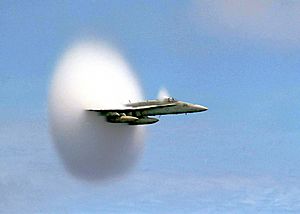Sound barrier facts for kids
Imagine a fast-moving airplane flying through the air. As it speeds up and gets close to the speed of sound, the air around it starts to behave differently. There are big changes in air pressure, creating special waves around the plane. This pressure keeps building up until the plane reaches the exact speed of sound, which we call Mach 1. At this point, the pressure suddenly drops, and you hear a loud burst of sound. This moment, when the plane hits Mach 1 and causes that burst, is often called the sound barrier. To fly faster than Mach 1, airplane wings had to be completely redesigned.
Contents
What is the Sound Barrier?
The sound barrier isn't a physical wall, but a challenge that early aircraft designers faced. Sound travels through the air as waves. When an airplane flies, it also creates its own pressure waves. If the plane flies slower than sound, these waves move ahead of the plane. But as the plane gets faster and closer to the speed of sound, it starts to catch up to its own sound waves.
How Does It Work?
When an aircraft reaches Mach 1, it's moving as fast as the sound waves it's creating. These waves pile up in front of the plane, forming a strong shock wave. This shock wave causes a sudden change in air pressure and density. It's like the air can't get out of the way fast enough. This creates a lot of drag and instability for the aircraft, making it very difficult to fly faster.
The Sonic Boom
When an aircraft breaks the sound barrier, it creates a loud noise called a sonic boom. This boom happens because the shock waves spread out behind the plane, reaching the ground as a sudden, powerful sound. It's not just one boom, but a continuous effect as long as the plane is flying faster than sound. People on the ground hear it as a loud "bang" or "rumble."
Breaking the Barrier
For many years, engineers thought it might be impossible for an aircraft to fly faster than the speed of sound without breaking apart. This is why it was called a "barrier." Early planes struggled with control and stability problems when they got close to Mach 1.
The First Supersonic Flight
The sound barrier was finally broken on October 14, 1947. An American pilot named Chuck Yeager flew a special rocket-powered plane called the Bell X-1. He flew it over the Muroc Dry Lake in California. Yeager successfully flew the X-1 faster than Mach 1 in level flight, proving that humans could indeed fly faster than sound. This was a huge step forward in aviation history.
Aircraft Design Changes
To overcome the sound barrier, aircraft designers had to make big changes. They developed new shapes for wings, such as swept-back wings, which help reduce the drag caused by shock waves. They also designed more powerful jet engines to push planes through the air at incredible speeds. Modern fighter jets and some passenger planes (like the Concorde, which is no longer flying) are designed to fly much faster than sound.
Images for kids
-
U.S. Navy F/A-18 transonic pushing into the sound barrier. The supersonic white cloud is formed by decreased air pressure and temperature around the tail of the aircraft (see Prandtl–Glauert singularity).
-
The prototype Miles M.52 turbojet powered aircraft, designed to achieve supersonic level flight
-
Chuck Yeager in front of the Bell X-1, the first aircraft to break the sound barrier in level flight
See also
 In Spanish: Barrera del sonido para niños
In Spanish: Barrera del sonido para niños






